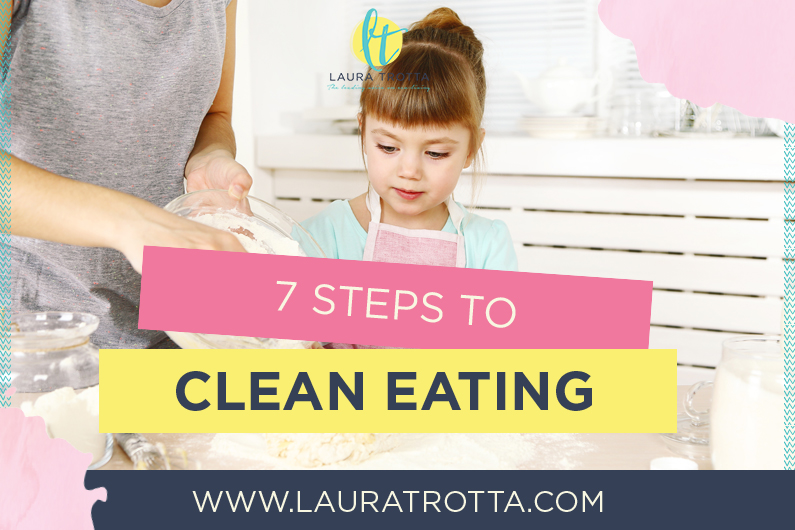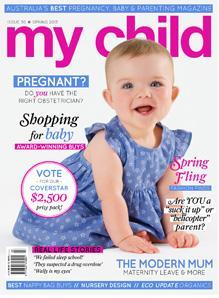 For as long as I can remember I have loved cooking. Some of my fondest memories as a young girl involve me sitting on a stool at the kitchen bench helping my mother prepare dinner. Whether it was chopping vegies for a pot of soup, mincing meat for pasties, or sifting flour for homemade cakes, I cherished these moments alone with my busy mum.
For as long as I can remember I have loved cooking. Some of my fondest memories as a young girl involve me sitting on a stool at the kitchen bench helping my mother prepare dinner. Whether it was chopping vegies for a pot of soup, mincing meat for pasties, or sifting flour for homemade cakes, I cherished these moments alone with my busy mum.
What I didn’t realise at the time was these special moments were indeed teaching me the skills of preparing and cooking healthy meals from scratch. Mum taught me most of what I know about “clean eating” before the phrase even existed.
Clean eating can be defined as consuming more whole, natural and unprocessed foods (think vegies, pulses and meat). It is not an extreme movement and doesn’t require you to switch to an entirely organic or vegetarian diet. It is more a lifestyle choice and a way of eating. Clean eaters are mindful of what food they consume and how it affects the environment.
The term has become a bit of a catchcry lately and for many good reasons. Not only are one in four Australian kids overweight or obese, but our average diet is the most processed and artificial it has ever been. Increasing numbers of children are reporting food allergies and intolerances, and diet has been linked to disorders including ADHD. If we are truly what we eat, Australians today are a long list of numbers and words that no-one can pronounce correctly.
Our love affair with processed and packaged foods is putting a strain on our environment. Waste generated by food packaging is at an all time high, along with energy and water used in food production. It’s not surprising that the case for change for clean eating is as great as ever. Yet with both parents working in many households, it is easy to see why convenience often wins over.
Like most changes worth making, the switch to eating cleaner involves commitment and time but the benefits for you and your children are lifelong. The following seven steps will help get you started.
1. Find your Friends
Chances are you will have friends who are also trying to eat cleaner. Enlisting them as your supporters will help make you accountable and more likely to succeed.
2. Get Organised
Allocate time each week to plan healthy meals and devise your shopping list. Give yourself enough time to prepare your meals. I often cook in bulk and freeze meals so I have some up my sleeve on those evenings I’m running late or can’t be bothered.
3. Shop Smarter
Eat foods that are in season and consider purchasing direct from producers at your local farmer’s market. When in the supermarket stick to the outer perimeter and purchase mainly fruits, vegies and meats. If something is packaged it is likely to have been processed and contain preservatives and other additives.
4. Become a farmer
Cultivate your own vegetable garden. Plant herbs or tomatoes in pots and get your kids involved. They’ll appreciate where food comes from and are more likely to eat their fruit and vegies if they’ve helped grow them.
5. Learn to read food labels
Phrases such as “fat free”, “wholegrain”, “organic” and “sugar free” have most of us bluffed into thinking the product is actually nutritious. Organic corn chips, for example, are still corn chips and are high in fats, salt and flavour enhancers. Learn the alternative names for sugars and avoid foods with lots of numbers or unpronounceable ingredients.
6. Package your food wisely
Use plastic wrap and snap-lock bags sparingly or get rid of them altogether and package your meals in containers. My children love their compartmentalised bento-style lunchboxes, and I must admit I do too!
7. Think about what you drink
Water and herbal tea are your friend. Alcohol, fruit juice and soft drinks are not.
As the chef and nutritionist in my household, I take the responsibility of instilling healthy eating habits and cooking skills in my children seriously. In a few short years they could well be the eight-year-old in the school playground eyeing off the packet of crisps in their friend’s lunch box, just as I did when I was a child. I am confident they will thank me years down the track for their clean diet, just as I am thanking my own mother now.
About the author: Laura Trotta is an eco mum, environmental engineer and founder of Sustainababy. She is passionate about helping parents lead a more sustainable lifestyle. Laura lives in regional South Australia with her husband and two young sons.
This article was featured in Issue 30, Spring 2013 of My Child Magazine.
- Sustainable Home Design- factors to consider to maximise sustainability - July 28, 2022
- Advantage and Disadvantages of Tiny Houses - May 31, 2022
- How School Strike 4 Climate is Empowering Youth to Fight for Their Future - May 1, 2022



 Laura Trotta is one of Australia’s leading home sustainability experts. She has a Bachelor of Environmental Engineering, a Masters of Science (in Environmental Chemistry) and spent 11 years working as an environmental professional before creating her first online eco business, Sustainababy, in 2009. She has won numerous regional and national awards for her fresh and inspiring take on living an ‘ecoceptional’ life (including most recently winning the Brand South Australia Flinders University Education Award (2015) for the north-west region in SA and silver in the Eco-friendly category of the 2015 Ausmumpreneur Awards). With a regular segment on ABC Radio and with her work featured in publications like Nurture Parenting and My Child Magazine, Laura is an eco thought leader who’s not afraid to challenge the status quo. A passionate believer in addressing the small things to achieve big change, and protecting the planet in practical ways, Laura lives with her husband and two sons in outback South Australia.
Laura Trotta is one of Australia’s leading home sustainability experts. She has a Bachelor of Environmental Engineering, a Masters of Science (in Environmental Chemistry) and spent 11 years working as an environmental professional before creating her first online eco business, Sustainababy, in 2009. She has won numerous regional and national awards for her fresh and inspiring take on living an ‘ecoceptional’ life (including most recently winning the Brand South Australia Flinders University Education Award (2015) for the north-west region in SA and silver in the Eco-friendly category of the 2015 Ausmumpreneur Awards). With a regular segment on ABC Radio and with her work featured in publications like Nurture Parenting and My Child Magazine, Laura is an eco thought leader who’s not afraid to challenge the status quo. A passionate believer in addressing the small things to achieve big change, and protecting the planet in practical ways, Laura lives with her husband and two sons in outback South Australia. 


